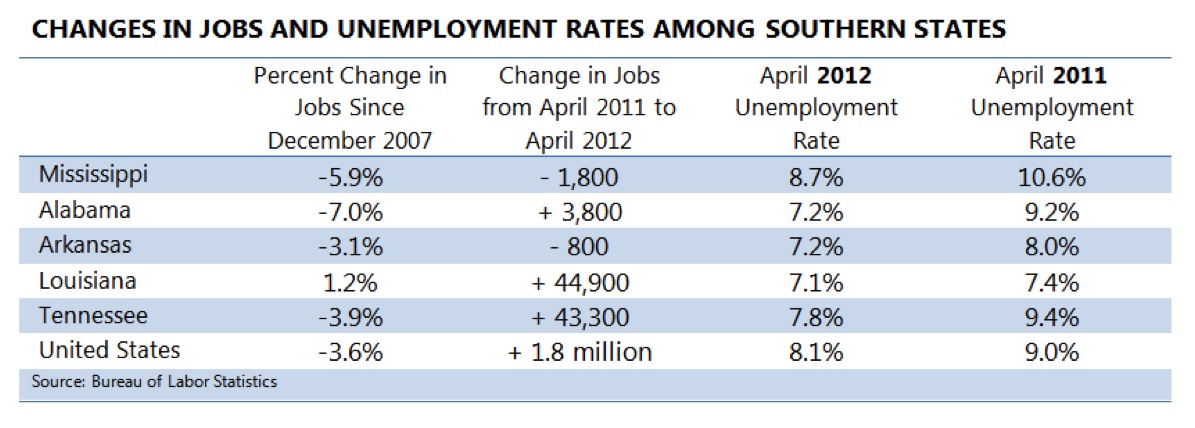May Job Watch: State’s Overall Employment Lower Than One Year Ago
May 22nd, 2012
Mississippi’s unemployment rate ticked down for the 7th straight month in April according to the most recent release. Mississippi’s April 2012 unemployment rate registered at 8.7% compared to 9.0% in March. The national economy added 115,000 jobs in April, the job gains paired with slight decrease in the national unemployment rate to 8.1%.
While Mississippi’s unemployment rate continues to slope downward, the state has not seen employment grow. How is this possible?
Mississippi’s overall employment is 1,800 jobs lower than it was one year ago in April 2011. However, an even larger number of adults have left the labor force and stopped searching for employment which leads to a lower unemployment rate.
The table compares job changes and unemployment rates for Mississippi and neighboring Mid-South states. Mississippi and Arkansas are the two states with declines in employment from April 2011 to April 2012 (2ndcolumn). Overall, Alabama has seen a larger dip in employment than Mississippi since the recession began in December 2007. Alabama is still 7.0% below pre-recession employment while Mississippi has 5.9% fewer jobs than before the recession. In both April 2012 and April 2011 Mississippi registered the highest unemployment rate for the Mid-South region.
A lack of employment growth in Mississippi has led to net job loss in 2011. According to state economist Darin Webb this is the fourth consecutive year of job declines for the state overall. Persistent job declines have been paired with a slower recovery than other Mid-South states. In fact, among all southeastern states, Mississippi has had the slowest employment change in the first quarter of 2012.¹
Mississippi’s labor market conditions illustrate that the state’s recovery trails the nation and the region. As leaders look to generate job growth and increase workforce skills, they should prioritize efforts that incorporate adults with lower skill levels and consider the distinct needs working-age students.
In particular, it is critical that stronger connections are built between college-level courses and adult basic education, GED and developmental education courses. Only through strengthening these connections will more adults we able to enter basic courses and advance to courses that prepare them for quality-wage employment. These connections have the potential to raise more of the state’s workforce to higher wages, create greater prosperity among families and meet more employer hiring demands for prepared workers.
Author: Sarah Welker, Policy Analyst






